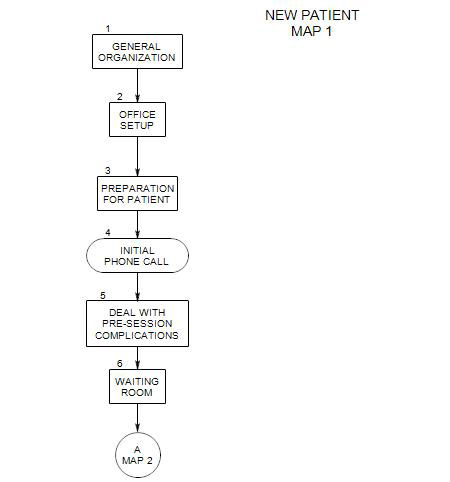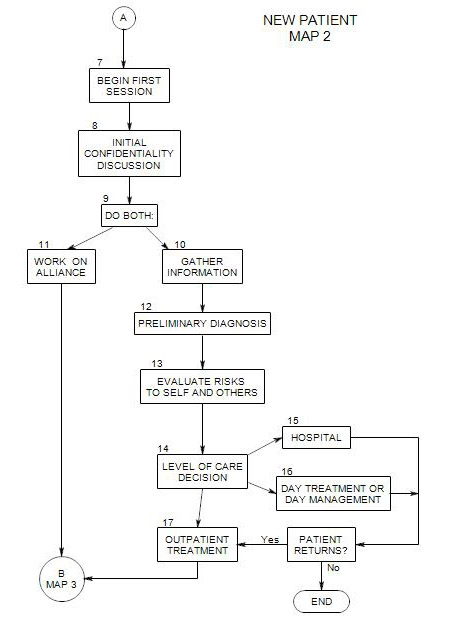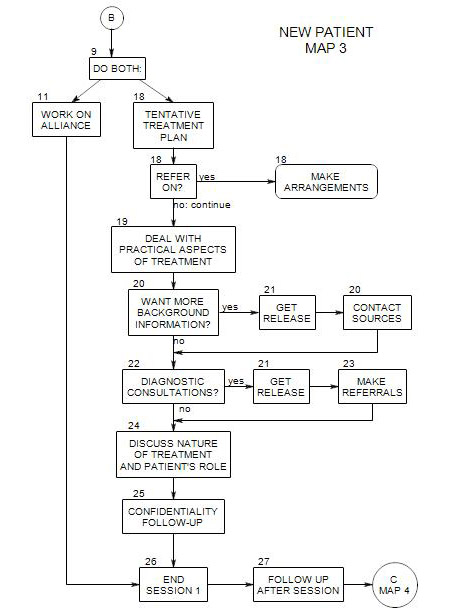-
Comes from Map 1
1a. Preparatory Decisions
You should already have decided
- Length of first session for individual adults, couples, families, children
- Typical length of subsequent sessions, for adults, couples, families, children
- Fee [if any] for first session
- Your usual fee for adults, couples, families, children. How to deal with inability to pay, and how much you are prepared to reduce fees for hardship.
- Type of payment you will accept: cash, check, indemnity insurance, managed care, etc.
- If managed care, which plans you will accept and what each one needs in order to open a case. Have data forms ready.
- Whether you intend to take notes or not, audiotape or not.
- Whether you will take telephone calls during sessions
1b. Therapist Theoretical Orientation
The material covered on this entire site includes issues that need to be considered in treating patients. Which of this you consider important to gather and when you decide to gather it will depend in part on your theoretical orientation.
- Cognitive and behavioral therapists may choose to be direct in gathering information about a person’s history, family, medical issues, use of alcohol or recreational drugs, etc.
- Psychodynamically oriented therapists may be more likely to wait for some of the information to emerge.
- Most therapists seem to prefer to call themselves eclectic, implying that they will vary their approach in response to the patient’s apparent need or the predicted effectiveness of the approach chosen.
The suggestions on this site are intended to be compatible with different orientations. If at times they are not, please suggest ways to expand or alter the presentation to make them more compatible with the way you work.
1c. Patient Expectations of Improvement
People come for treatment in hope of change for the better. Some expect that they will have to change and some even want to change. Many only want help in changing the circumstances in which they find themselves or the people around them.
There are two things you should be committed to accomplishing immediately
- determining whether you can be helpful in some way
- if so, then keeping the patient in treatment
However you work, it should encourage people to believe that their lives can improve. If you have difficulty keeping patients, you may need to re-evaluate the way you work to be more encouraging and immediately helpful to them.
1d. Therapist Personal Style
The success or failure of therapy depends on many things, including-
- whether the at least some of the person’s symptoms can be relieved
- how clear you are about the process
- how comfortable the person feels
- how seriously you take the person
- how seriously the person takes you and the work
- how much the person trusts you
- how much the person is able to reveal
- whether you understand the person well enough to be helpful
Some of this will be conveyed to your patients through your personal style: the extent to which you are
- formal or casual
- rigid or loose
- able to adapt to the patient’s style and needs
- self-revealing, or a blank slate
- directive or not
Some will also be inferred by patients through things you do. Whether you
- take notes during the sessions
- answer the telephone in session
- answer patient questions directly or deflect them
- dress casually or formally
- sit in a special chair or behind a desk or in a chair similar to the patient’s
Patients will actually make inferences about you from anything you do or don’t do, and different people may make different inferences. The psychoanalytic concept of transference relates to those inferences. If you are prepared to explore the ways in which a person interprets your appearance or behavior, it may help you understand how he/she interprets other people’s appearance or behavior as well. That, in turn, can have a bearing on the issues that he/she is having difficulty with.
1e. How You Work
This will follow from your theoretical orientation and personal style. You may
- Start where your patient is, and let the information come as it will. In this case, the treatment maps can guide your reactions to your patient, help you notice missing information, etc.
- Start where your patient is, and follow the thread of information actively. Then you can use the maps to develop directions to pursue.
- Do a broad-band data collection, under the assumption that a lot more could be happening than your patient is telling you.
- Pick a symptom and begin work on it immediately.
- Make a quick diagnosis and start from that perspective.
An overall treatment approach, minimum effective interventions, has been emphasized by modern insurance demands. However, effective depends on treatment goals, which can be more or less extensive. A patient’s treatment goals could be-
- just get over this issue, mostly.
- change the circumstances that precipitated this problem.
- change other people in the patient’s life so he/she doesn’t have to change.
- change the person’s attitudes that led to this problem.
- change the way the person reacts to others.
Your goals for a patient may differ from his/hers. But whatever goals you pursue, you may not know initially what kinds of interventions will be effective. A period of diagnostic work is generally advisable, to understand the patient ‘s issues clearly and fully in the broader contexts of his/her life, perspective, personality structure, etc.
Treatment can take many forms, depending on the person’s symptoms and issues, physical and medical status, work situation, interpersonal and family relationships, personality structure, etc. You may need to-
- arrange to treat possible medical causes for the patient’s symptoms
- advise the patient on environmental changes that could be producing the symptoms
- help the patient change his/her behavior or responses in specific situations
- teach coping skills
- examine the patient’s conscious attitudes and expectations about self and others
- help the person change interpersonal relationships
- look at unconscious motives, meanings and expectations
Your treatment choices will depend on many things, some of which you bring to the work, and some of which are brought by the patient. Our purpose here is to consider those things openly.
Your own personal style and training will help determine the points at which you are able to work most effectively. If it appears that the most effective intervention is outside your range, you may need to refer a patient on to someone who is familiar with that approach.



